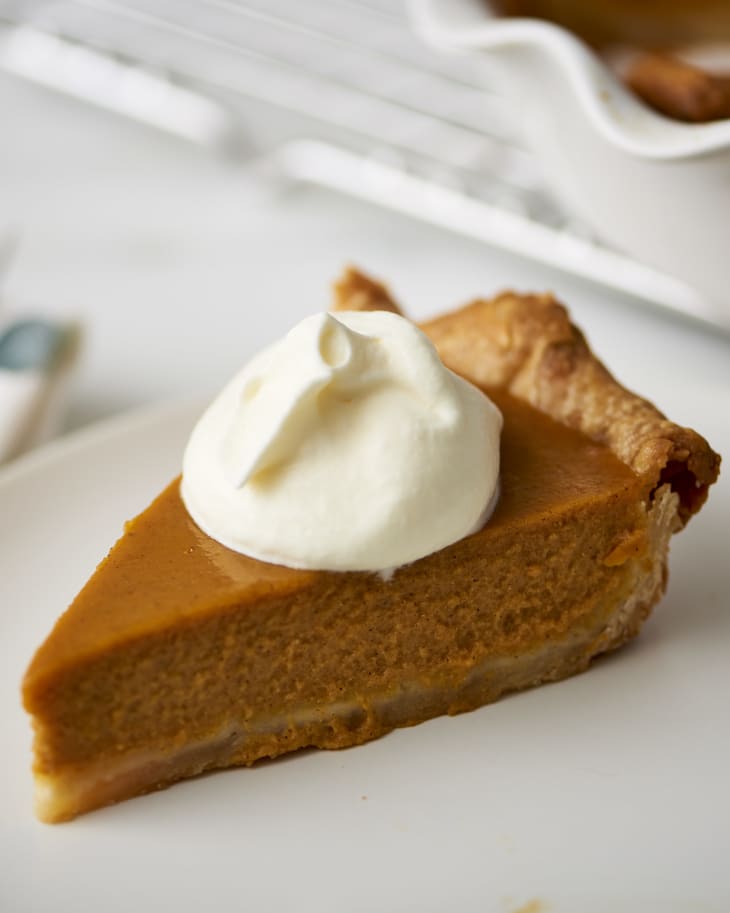4 Signs Your Pumpkin Pie Is Done and Ready to Serve
Pumpkin pie, a member of the custard pie family, is sometimes challenging to bake correctly. No, I don’t mean getting the perfect pie crust or the right spices — although those things certainly don’t hurt — I mean that custard pies are most often under- or over-baked. Pumpkin in particular is hard to read because of its dark filling. We tend to avoid poking and prodding pumpkin pie so that we can have a picture-perfect one.
Here’s how to tell pumpkin pie is done — so you can ensure that it’s the star of the dessert table.
How to Tell if Pumpkin Pie is Done
The best way to tell if pumpkin pie is done without ruining a picture-perfect custard is to give it a nudge. If the pie jiggles (but doesn’t wiggle), then it’s done. You should also see that the filling has darkened and the texture of the pie should be a bit puffed up from when you put it in the oven.
If you’re still uncertain, stick a knife (or a toothpick) in the center and see if it comes out clean. You can also stick in an instant-read thermometer in the middle. When it’s done, it will register a temperature of at least 175°F.
1. The filling is darker and slightly puffed.
Around the suggested baking time in your recipe, your pumpkin pie’s filling (and crust) should deepen in color. The filling should be slightly raised and there maybe some cracking around the edge where the filling meets the crust. The puff of the pie will relax as the pie cools, hiding many of the cracks as well.
2. It “jiggles” but doesn’t “wiggle.”
This is a technique that they actually teach in baking schools: Gently nudge your pie. The center of the pie should have some give — it jiggles — but it shouldn’t wobble or wiggle. If the whole pie is wobbly, continue baking. When in doubt, bake the pie a little longer rather then risk an under-baked pie.
3. A knife test comes out clean.
When in doubt, you can always fall back on the classic cake test: A knife inserted into the edge of the filling comes out moist but clean. You can even look for a small crack along the edge to insert your knife with out ruining the top of your pie. (If you want an even smaller footprint, you can also test for doneness with a toothpick.)
4. A thermometer reading is at least 175°F.
Okay so this definitely involves poking and prodding a pumpkin pie, but if you’re really puzzled as to whether or not your pie is done, try sticking an instant-read thermometer in the center of the custard. If it reads at least 175°F it’s done. (Hot tip: Cover the spot the thermometer broke through with a dollop of whipped cream and no one will be the wiser.)
If the center of the pie registers below 175°F, then stick it back into the oven and check on it every 5-10 minutes until baked through. If the custard in the center isn’t done yet but the crust is starting to get crispy, you can protect it using a pie shield while it finishes baking.
Cool Before You Cut Pumpkin Pie
Out of the oven, cooling is another important step to ensure your pumpkin pie is done. Always cool the pie completely before slicing. Custard pies continue to cook as they cool; cutting into a warm pie may result in a small landslide of filling instead of a pristine slice.
Signs Your Pumpkin Pie is Overcooked
While a wobbly, runny pie is a telltale sign that a pumpkin pie is undercooked, an overcooked pumpkin pie is a bit harder to spot. When you’ve overcooked a pumpkin pie, you may see:
- The filling separating from the crust
- The filling has visible cracks
- The pie has small bubbles forming along the filling
- The pie just overall looks burnt
